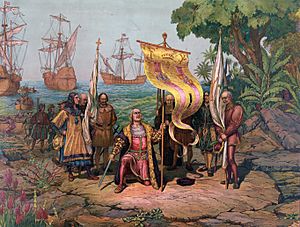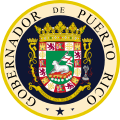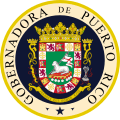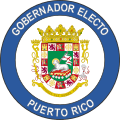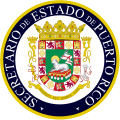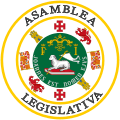Coat of arms of Puerto Rico facts for kids
Quick facts for kids Coat of Arms of Puerto Rico |
|
|---|---|
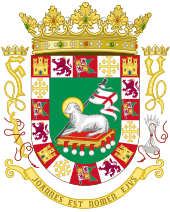 |
|
| Versions | |
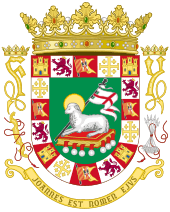
Variant
|
|
| Armiger | Estado Libre Asociado de Puerto Rico (Commonwealth of Puerto Rico) |
| Adopted | 1511 |
| Motto | Joannes Est Nomen Eius, Latin "John is his name". |
The coat of arms of Puerto Rico is a special symbol for the island. It was first given by the Spanish rulers on November 8, 1511. This makes it the oldest official symbol still used in the Americas today!
After the Spanish–American War in 1899, Puerto Rico became part of the United States. For a short time, two different symbols were used. But in 1905, a law brought back the old, historical design. Then, in 1976, after some updates, the current version was officially adopted.
Contents
History of the Puerto Rico Coat of Arms
The main ideas behind the coat of arms show Spain's influence and the strong Roman Catholic faith in Puerto Rico. It also shows that Puerto Rico was a Spanish colony. The design of the coat of arms has changed a few times throughout history. The current version was officially brought back by the government of Puerto Rico on June 3, 1976.
Here's what the different parts of the shield mean:
- The green background stands for the island's lush plants and trees.
- The Lamb of God and the cross flag are symbols connected to Saint John the Baptist. He is the patron saint of the island.
- The book with seven seals, where the lamb sits, comes from the Book of Revelation. This part is usually linked to Saint John the Apostle.
- The border around the shield has 16 different parts. These include castles and lions, which represent the old kingdoms of Castile and León in Spain.
- There is also a flag with the symbols of Castile and León. The Cross of Jerusalem is there too. This cross stands for the Kingdom of Jerusalem, whose rights eventually passed to the Spanish Crown.
- The gold-crowned letter F and arrows stand for King Ferdinand II of Aragon. The letter Y and the yoke (a wooden bar for animals) stand for Ysabel, which is Queen Isabella I of Castile. These two were the Catholic monarchs when Puerto Rico was first found.
- The Latin phrase, "JOANNES EST NOMEN EJUS," is the motto. It means "John is his name." This refers to Saint John the Baptist, or San Juan Bautista. This was the original name of the island.
| Great Seal of Puerto Rico | |
|---|---|
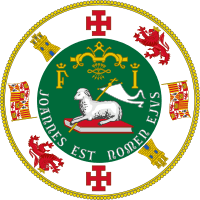 |
|
| Armiger | Commonwealth of Puerto Rico |
| Motto | Joannes Est Nomen Ejus, Latin "John is his name". |
The Great Seal of Puerto Rico
Like all U.S. states and territories, Puerto Rico has a special seal. This seal is used to make official documents real and valid. While the traditional coat of arms is the main symbol, the Great Seal is used for legal papers.
The Great Seal looks a lot like the coat of arms. However, some religious symbols have been changed. This is because of the idea of keeping church and government separate. For example, the lamb on the seal no longer has a halo. It carries a white flag instead of one with a red cross. The lamb's staff also does not have a cross on top. The book the lamb sits on does not have the seals from the Book of Revelation.
In the past, the first Governors used this seal as their symbol. But now, the seal is mostly used to officially mark legal documents from Puerto Rico.
Seal of the Governor of Puerto Rico
The Seal of the Governor is the official symbol for the leader of Puerto Rico. Its design is similar to the Seal of the President of the United States. There are a few different versions of the Governor's Seal that are used.
Seals of the Government of Puerto Rico
Different parts of the Puerto Rican government also have their own seals.
Images for kids
-
Seal of the Governor of Puerto Rico
See also
 In Spanish: Escudo de Puerto Rico para niños
In Spanish: Escudo de Puerto Rico para niños


